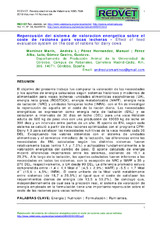| dc.contributor.author | Martínez Marín, Andrés L. | |
| dc.contributor.author | Pérez Hernández, Manuel | |
| dc.contributor.author | Pérez Alba, L.M. | |
| dc.contributor.author | Gómez-Castro, A.G. | |
| dc.date.accessioned | 2012-12-05T13:22:01Z | |
| dc.date.available | 2012-12-05T13:22:01Z | |
| dc.date.issued | 2010 | |
| dc.identifier.uri | http://hdl.handle.net/10396/8394 | |
| dc.description.abstract | El objetivo del presente trabajo fue comparar la valoración de las necesidades
y los aportes de energía calculados según sistemas históricos y modernos de
alimentación para vacas lecheras -unidades alimenticias escandinavas (UA),
energía neta grasa (ROSTOCK), energía metabolizable (MAFF), energía neta
de lactación (NRC) y unidades forrajeras leche (INRA)- con el fin de investigar
la repercusión de aquella en el coste de la ración diaria. Las necesidades
energéticas se expresaron como energía neta de lactación (ENL) y se
calcularon a intervalos de 30 días en leche (DEL) para una vaca Holstein
adulta de 680 kg de peso vivo con una producción de 10000 kg de leche en
305 días y un intervalo entre partos de un año. El aporte de ENL según cada
sistema se calculó a partir de diez raciones optimizadas con el programa CPMDairy
1.0 para satisfacer las necesidades nutritivas de la vaca modelo cada 30
DEL. Exceptuando los valores obtenidos con el sistema de unidades
alimenticias y el comienzo inmediato de la lactación, las diferencias entre las
necesidades de ENL calculadas según los distintos sistemas fueron
relativamente bajas (entre 1,1 y 7,5%) y achacables fundamentalmente a la
valoración energética del cambio de peso. El aporte calculado de energía
mostró diferencias importantes entre los sistemas, oscilando de 19,1 a
25,2%. A lo largo de la lactación, los aportes calculados fueron inferiores a las
necesidades en todos los sistemas, con la excepción de NRC y MAFF a 30 y
270 DEL, respectivamente, y UA desde 90 DEL. La diferencia promedio estuvo
comprendida entre -1,4 ± 1,1 Mcal d-1 (4,5 ± 2,9%; MAFF) y -5,5 ± 1,7 Mcal
d-1 (15,6 ± 4,5%; INRA). El coste unitario de la Mcal varió notablemente
entre sistemas (de 18,7 a 25,5%) al igual que el coste de satisfacer los
requerimientos diarios de energía (de 13,5 a 50,2%). Se concluyó que,
independientemente de cual sea la precisión real, el sistema de valoración de
energía empleado en la formulación tiene una importante repercusión sobre el
coste de las raciones para vacas lecheras | es_ES |
| dc.description.abstract | The objective of the present work was to compare energy requirements and
supply calculated according to old and modern feed evaluation systems for
dairy cattle - Scandinavian feed units (UA), net energy fat (ROSTOCK),
metabolizable energy (MAFF), net energy of lactation (NRC) and milk fodder
units (INRA) - to assess the differences in the cost of the ration. The energy
requirements were expressed as net energy of lactation (NEL) and were
calculated every 30 days in milk (DIM) for a mature Holstein cow weighing
680 kg, producing 10000 kg of milk in 305 days, and calving every year. Ten
rations optimized with CPM-Dairy 1.0 to satisfy the nutritional requirements of
the model cow every 30 DIM were used to compare the calculated NEL supply
according to the systems being evaluated. Except for the values obtained
according to the feed units system and the onset of lactation, the differences
between the systems in the calculated energy requirements were relatively
low (from 1.1% to 7.5%) and mainly attributable to the energy value
assigned to the live weight change. The differences between the systems in
the NEL supply of the rations were high and oscillated between 19.1% and
25.2%. The calculated supplies were smaller than the requirements in all the
systems throughout lactation, except for UA from 90 DIM and NRC and MAFF
at 30 and 270 DIM, respectively. The average differences were in the range
from -1.4 ± 1.1 Mcal d-1 (4.5 ± 2.9%; MAFF) to -5.5 ± 1.7 Mcal d-1 (15.6 ±
4.5%; INRA). The cost of the Mcal differed between the systems (from 18.7%
to 25.5%) and the same was true for the cost of satisfying the daily energy
requirements (from 13.5% to 50.2%). It was concluded that, without taking
into account the real accuracy, the energy evaluation system used in the
formulation affects considerably the cost of rations for lactating dairy cattle. | es_ES |
| dc.format.mimetype | application/pdf | es_ES |
| dc.language.iso | spa | es_ES |
| dc.publisher | Veterinaria.org | es_ES |
| dc.rights | https://creativecommons.org/licenses/by-nc-nd/4.0/ | es_ES |
| dc.source | REDVET. Revista electrónica de veterinaria 11 (4), 1-10 (2010) | es_ES |
| dc.subject | Energy | es_ES |
| dc.subject | Nutrition | es_ES |
| dc.subject | Formulation | es_ES |
| dc.subject | Ruminants | es_ES |
| dc.subject | Energía | es_ES |
| dc.subject | Nutrición | es_ES |
| dc.subject | Rumiantes | es_ES |
| dc.title | Repercusión del sistema de valoracion energetica sobre el coste de raciones para vacas lecheras | es_ES |
| dc.title.alternative | Effect of feed evaluation system on the cost of rations for dairy cows | es_ES |
| dc.type | info:eu-repo/semantics/article | es_ES |
| dc.rights.accessRights | info:eu-repo/semantics/openAccess | es_ES |

